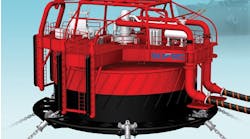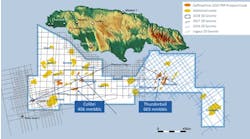The mammoth Shaybah project will rise from this desolate sand sea in Saudi Arabia's Rub al Khali. (Photo by S. M. Amin)
Iraq's return
In case you didn't notice, the uncertainty is over; Iraqi oil is back on the market to the tune of billion-dollar sales every 90 days of some 700,000 b/d in production for the next six months, and thereafter, if Saddam Hussein keeps his promises. Iraq and the UN signed the long negotiated memorandum of understanding permitting the sale for humanitarian purposes - primarily aid to the destitute Iraqi population, including the Kurd minority, which will be handled by the UN, and reparations to be paid to Kuwait.Iraq had no choice but to sign the agreement hammered out by UN Secretary General Boutros Boutros Ghali, the US and UK chief negotiators, and Iraq's Abdul Al-Anbari; the country sorely needed the food, medicine, and assistance the sale of oil will provide. The country has been under embargo since August 1990.
But the bottom didn't fall out of the international petroleum market upon the news, barely a ripple was felt. Prices and stock levels actually went up a bit. Analysts disagree on future consequences. Salomon Brothers predicts that the next few months could get treacherous for prices and expects a downward pressure, while Natwest Securities maintains that there could be a very small dip in price, but that the industry is strong and getting even stronger. Market demand is great enough, in fact, to incorporate Iraqi exports this year without any significant fall in prices. But OPEC ultimately is the determining factor in a world market wherein Iraq continues to contribute 700,000 b/d - and will likely ask for and get an increase to a million b/d after the first six months.
OPEC is presently producing 26 million b/d, including the cheating of 1.3 million b/d by Nigeria, Venezuela, Iran and Qatar over established quotas. Saudi Arabia refuses to reduce its production to accommodate Iraqi oil while such cheating is going on. Thus if a temporary quota is given to Iraq, world supply and demand can be kept at a healthy level if the overproducing OPEC members bring their production back in line with their quotas, an unlikely occurance.
It appears likely, therefore, that 1997 will see a drop in oil prices to somewhere between $17 and $19 per bbl as a consequence of the persistent cheating OPEC members and the return of Iraq to the world market.
Development in a sea of sand
News of Saudi Aramco's decision to develop the Shaybah Field evoked memories of some of the marvelous schemes put forth back in the Seventies for dealing with sand. The Shaybah project is, after all, out in the sea of sand Saudi Arabia calls the Rub al-Khali.Shaybah Field is a supergiant, with reserves greater than the entire UK North Sea - at least 7 billion bbl of light, sweet crude (41.5 API). It was discovered decades ago, but because of its remote, inhospitable location in the Empty Quarter away from existing infrastructure, was considered too costly and too difficult to develop until now. (Although it lies in the desert frontier between Saudi Arabia and Abu Dhabi, a secret agreement made 20 years ago provides that all resources from the field belong to Saudi Arabia.)
Last year, Saudi Aramco announced a fast-track development plan for Shaybah with a goal of producing approximately 500,000 b/d by December 1999, from some 250 wells, but now that date has been moved up to 1998 with production set at an even million bbl per day.
To bring about such a project, with a price-tag of approximately US$2 billion, will take an army of workmen and technicians laboring in what is probably the world's most hostile desert terrain, 550 km west of the Ghawar Field, the Kingdom's nearest connection to existing industry infrastructure. It will require a minimum of 6,000 workers and necessitate their housing, transportation, and feeding. It will mean construction , of new infrastructure, production facilities, and pipelines where no roads exist, where liquid, sweeping sand dunes drift in waves up to 100 ft high and form mountainous ridges that rise to 800 ft above the solid sand and stone.
The task of developing Shaybah will be daunting even with today's technology and may very well require the kind of science fiction solutions envisioned in the mid-1970s - such things as adapting offshore mobile drilling unit designs and those for production and accommodation platforms for work in the sand sea and chemically solidifying sand to provide stable bases upon which to build. The Ralph M. Parsons Company is to coordinate development operations by a who's who of international companies, but no precise plans have been revealed yet, nor have any contracts been let.
The possibilities are fascinating to imagine: the construction of huge drilling and production platforms not unlike those that populate the North Sea that would rise above the crests of an ocean of undulating dunes, of domed, air-conditioned dwellings rising on bridge-linked monopods above the sand, of a parade across the desert of unmanned minimal platforms, control centers, and giant gas/oil separation plants - all connected by a network of tressels and walkways beyond the blowing sand.
Briefs:
Americas:
Texaco stepping up its deepwater program, has plans to test two more of its Gulf of Mexico deepwater prospects this year, Gemini and Fuji, according to Peter Bijur, vice chairman and CEO elect. Wells were drilled on both Fuji and Gemini last year, and again on Fuji this year. Both are operated by Texaco, in partnership with Shell and Chevron, respectively.
Exxon's Diana deepwater discovery is to be developed. The company is studying designs for a production system for placement on its East Breaks Blocks 945 and 946, where a 1,400 ft hydrocarbon column was confirmed. The site is 120 miles south of Freeport, Texas in 4,657 ft water depth. Three wells tested 4,838 b/d oil and 2.6 million cf/d gas.
Trinidad's local MoraVen has obtained an E&P license for the Mora Field, which lies approximately 10 miles off the northeast coast of Galeota Point, Trinidad, five miles northwest of Amoco's Poui Field, in 120 ft water. Operator is Krishna Persad & Assoc., a major shareholder. The field was purchased from Amoco and has annual production of 180,000 bbl oil.
Amoco Trinidad had two finds recently, however. The first, the East Mayaro-5, was an oil and gas discovery less than 50 miles east of Galeota Point. It tested 3,400 b/d oil and 34.9 million cf/d gas from the deepest of five zones. Eight miles south of this field, Amoco made a second siginficant discovery with its Corallita-1 well, an untested major gas find.
Europe:
Russia's Rosshelf and Gazprom have announced four licensing rounds for the Barents and Pechora Seas during the next six years. This year, the first round will offer two Barents Sea blocks off Murmansk and the Pomorskoye Block in the Pechora Sea. During 1997-98, the Ledovoye Block in the Barents Sea will be offered, as will a block adjacent to Pomorskoye. In 1999-2000, the Shtokmanovskoye Block and a block off Novaya Zemlya will be offered, and in 2001-02, two additional blocks in the central Barents will be offered. The Prirazlomnoye, Ludovskoye, and several other highly prospective blocks will be retained for domestic licensing. 3D seismic surveys are being conducted by both Sevmorneftegeofizika and Geco-Prakla.
Mideast:
Yet another Egypt discovery has been made by Amoco in the Gulf of Suez. The East Tanka-3 well tested 4,884 b/d oil and 3.7 million cf/d gas. A fast-track development program is planned to bring the field onstream by next year. It is located adjacent to existing infrastructure that will facilitate its development.
Iran has officially signed to buy 10% of the Azerbaijan Shaikh Deniz Field in the south-central Caspian Sea. OIEC, the Iranian Engineering & Construction Co., is the new shareholder, however, not exactly NIOC, which owns 40% of OIEC. BP, with 25.5%, will be operator. Other partners are Elf, Lukoil, TPAO, and Statoil, as well as Socar.
Africa:
Nigeria is launching a program to maximize oil production from its marginal fields. Dan Etete, petroleum resources minister, says approximately 800 million bbl oil reserves are undeveloped in the Niger Delta alone. Plans are to emulate the marginal fields programs of the North Sea and Venezuela.
Tunisia's Ramla Block will see an exploratory well drilled this fall by operator Union Texas. Significant hydrocarbons were found there last year by the discovery well, but it was declared non-commercial. New seismic has repositioned drilling plans, however.
Asia:
Vietnam's Block B goes to Unocal in a production sharing contract with PetroVietnam. The 1.3 million acre plock in the northern Malay Basin is highly gas prone and will likely be tied into Unocal's major Gulf of Thailand pipeline system. First wells should be drilled early next year. Repsol and Mitsui are Unocal's partners.
Philippines Manila Bay discovery by Cophil Exploration, Coplex Resources, and their partners Oriental Petroleum and Pacrim Energy appears to be a major play. The JV, into which British Gas has an option to farm in at 25%, expects to find reserves enough to provide Metro Manila with its power needs.
It's first come, first serve in New Zealand. Virtually all of the country's unassigned aquatory is up for bid under a new fiscal regime and regulations, recently approved. Geophysical work is ongoing, but exploratory drilling is scheduled by Petrocorp in Taranaki. Several blocks are up for grant offshore the east coast of the North island.
Australia's Zone giant Undan/Bayu is exceeding expectations. Total reserves are now estimated at 6 tcf gas, 420 million bbl condensate, and 365 million bbl LPG, making it one of Australia's largest discoveries. Located in ZOCA 91-12 and 91-13, unitization of the two permits is being studied.
Indonesia is offering frontier terms on blocks in the Indonesian Timor Sea near the recent discoveries in the Zone of Cooperation between Australia and Indonesia and in Australian waters.
Myanmar has signed a production sharing agreement with Arco for Block M-7, just east of Total's Block M-5 with its 5.7 tcf Yadana gasfield and Block M-6. The 5,163 sq mile block in the Gulf of Moattoma, is said to contain good prospects for additional gas. Arco already holds Block M-9 to the south.
China has signed a production sharing agreement with Chevron for Block 63/15, near Chevron's 62/23 and 50/20 concession areas in the Yinggehai and Qiongdongnan basins of the South China Sea, not far from Arco's giant gasfield Ya 13-1 and CNOOC's Dongfang 1-1 and Ledong 15/1.
Copyright 1996 Offshore. All Rights Reserved.



